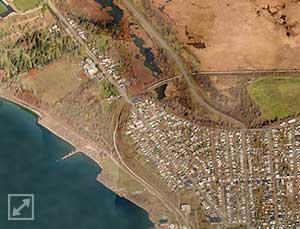Landscape Lenses
Physical Landscape
 The physical landscape is the starting point of our investigation into the natural and cultural history of Burlington. We can think of the physical landscape as the stage that supports the cast of human and non-human characters, the actors in an ever-unfolding story. Built of bedrock, surficial sediments, soils, topography, hydrology and climate, the physical landscape has been shaped by enormous geologic forces over millions of years. Since the retreat of the glacier from the Vermont landscape 12,000 years ago, many casts of characters have interacted and migrated across this relatively stable backdrop; plants and animals continually shift and evolve in response to their stage, the physical environment.
The physical landscape is the starting point of our investigation into the natural and cultural history of Burlington. We can think of the physical landscape as the stage that supports the cast of human and non-human characters, the actors in an ever-unfolding story. Built of bedrock, surficial sediments, soils, topography, hydrology and climate, the physical landscape has been shaped by enormous geologic forces over millions of years. Since the retreat of the glacier from the Vermont landscape 12,000 years ago, many casts of characters have interacted and migrated across this relatively stable backdrop; plants and animals continually shift and evolve in response to their stage, the physical environment.
Indeed, the nature of the physical landscape often defines and limits the distribution of plants, animals and people across the landscape. Climate and topography are two major factors that control a landscape’s exposure to sunlight and precipitation. Even locally, the shape and character of bedrock and surficial sediments will determine where certain plants and animals can thrive.
Aspects of the physical landscape have long controlled the distribution of people as well. Think of the Winooski River as it cuts through the steep Green Mountains into the Champlain Valley, then draining into Lake Champlain at Delta Park. This river corridor provides a sheltered and easily navigable path across the central part of the State, and also provides a rich floodplain for farming. The fact that a busy interstate, miles of agricultural fields, and a wide meandering river occur side by side is no coincidence.